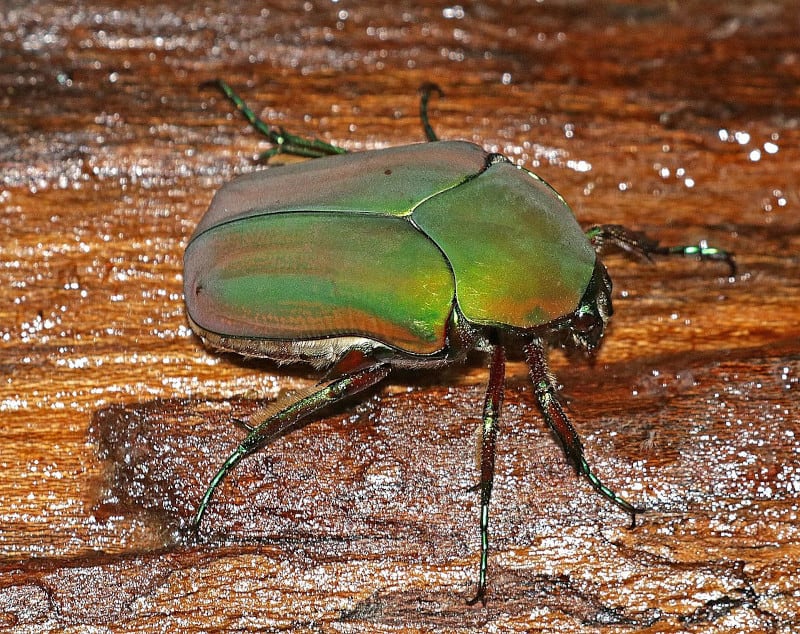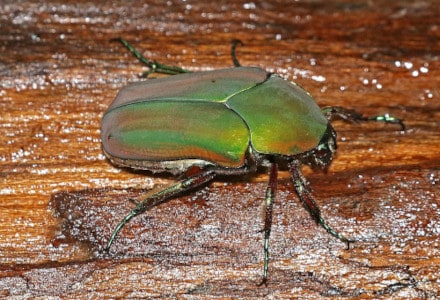
June Bug Facts
- This intriguing product of Nature and evolution most frequently goes by the appropriate common name of the June Bug. Yet it’s sometimes known by similar variations of this term. These include such titles as June Beetle and Green June Beetle.
- Among entomologists, however, it’s better known by its technical name. Fortunately for the interested layperson, that’s a relatively simple term, as such things go. That’s because this wonder of creation bears the formal name of Cotinis nitida.
- It received that reasonably simple technical name due to the efforts of Carl Linnaeus. The eminent Swedish zoologist and botanist accomplished the first recorded recognition of it as a separate and distinct species. He achieved that recognition in 1758.
- Regardless of the term one chooses to use, it remains a very fascinating insect. Unfortunately, though, it’s considered something of a destructive species. It’s also sometimes confused with another, related invertebrate that lives within the same range.
- Within its native territory, the June Bug appears to be maintaining a population base that’s both stable and sufficient. That situation further seems to hold true throughout the entirety of that range. The IUCN, therefore, currently does not list it on the Red List.
- The insect nevertheless does face the same potential threats as most other creatures. Most of them stem from the actions of man. These include such dangers as habtitat degradation and loss. It also now faces the perils posed by ongoing climate change.
Related Articles
June Bug Physical Description
The appealing June Bug is a variety of invertebrate that captures the attention of many people within its range of habitation. It’s usually of more interest for its sheer visual appeal, than simple physical size. That’s because the insect ranks as an average-sized beetle.
Unlike many of its relatives, though, it displays no noticeable degree of sexual dimorphism. Due to the lack of this physiological characteristic, adults of both genders remain virtually indistinguishable to the untrained eye. Yet what they does see merits appreciation.
Mature adults attain a total body length averaging from 0.6 – 0.9 in (15 – 22 mm). Exceptional individuals, however, sometimes measure up to 1.06 in (27 mm) in length. The body of the Arthropod also reaches an average width of approximately 0.5 in (12 mm).
It’s the exoskeleton of the aptly-titled June Bug, though, that usually gets the most attention. That’s due to the vibrant color scheme generally presented by fully mature adults. This background most commonly develops as an almost uniformly bright metallic green.
Nevertheless, a percentage of specimens present a very different appearance. Some individuals manifest a primarily dull brown background. In these cases, that’s typically accompanied by thin green stripes. The margins of the forewings also show orange yellow.
- Kingdom: Animalia
- Phylum: Arthropoda
- Class: Insecta
- Order: Coleoptera
- Family: Scarabaeidae
- Genus: Cotinis
- Species: C. nitida
June Bug Distribution, Habitat, and Ecology
The intriguing June Bug evolved as native to a somewhat small expanse of the globe. The location of that zone of habitation, though, won’t surprise many people. That’s true since it developed in a region of the world already known for its wide variety of insect life.
More precisely, it developed as endemic to the continent of North America. Even there, however, the small animal makes its home in only a specifc portion of it. The vast majority of its population appears in the east and midwest portions of the United States.
There, it lives from Florida in the southeast, to Texas in the west. Northward, though, this territory extends up into the midwest as far as Nebraska. In the far northeastern region, the natural marvel appears as far north as the southeastern portions of the country of Canada.
In all portions of that native range it displays the same preferences in where it makes its home. These, however, include a wide variety of ecosystems. Individuals often appear, sometimes in numbers, flying close to the ground. They prefer fields, lawns, and forests.
After mating, the female June Bug lays 60 – 75 eggs underground. These subsequently hatch after about 18 days, into the larval form. They mainly feed on mold and humus, but in numbers can severely damage plants and even lawns. Thus they’re considered pests.
The adults of the species typically finally appear in June, thus the name. These mainly feed on a variety of fruits. That includes grapes, peaches, berries, apples, nectarines, figs, and pears. Its own natural predators are quite numerous, including birds, especially blue jays.
Species Sharing Its Range
Check out our other articles on 4 Outstanding Orchids of Australia, Alligator Snapping Turtle, Victoria Falls, Wilson’s Bird-of-paradise, Bristlecone Hemlock

